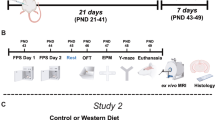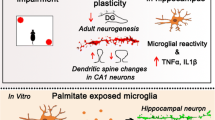Abstract
Early-life environmental insults have been shown to promote long-term development of chronic non-communicable diseases, including metabolic disturbances and mental illnesses. As such, premature consumption of high-sugar foods has been associated to early onset of detrimental outcomes, whereas underlying mechanisms are still poorly understood. In the present study, we sought to investigate whether early and sustained exposure to high-sucrose diet promotes metabolic disturbances that ultimately might anticipate neurological injuries. At postnatal day 21, weaned male rats started to be fed a standard chow (10 % sucrose, CTR) or a high-sucrose diet (25 % sucrose, HSD) for 9 weeks prior to euthanasia at postnatal day 90. HSD did not alter weight gain and feed efficiency between groups, but increased visceral, non-visceral and brown adipose tissue accumulation. HSD rats demonstrated elevated blood glucose levels in both fasting and fed states, which were associated to impaired glucose tolerance. Peripheral insulin sensitivity did not change, whereas hepatic insulin resistance was supported by increased serum triglyceride levels, as well as higher TyG index values. Assessment of hippocampal gene expression showed endoplasmic reticulum (ER) stress pathways were activated in HSD rats, as compared to CTR. HSD rats had overexpression of unfolded protein response sensors, PERK and ATF6; ER chaperone, PDIA2 and apoptosis-related genes, CHOP and Caspase 3; but decreased expression of chaperone GRP78. Finally, HSD rats demonstrated impaired neuromuscular function and anxious behavior, but preserved cognitive parameters. In conclusion, our data indicate that early exposure to HSD promote metabolic disturbances, which disrupt hippocampus homeostasis and might precociously affect its neurobehavioral functions.





Similar content being viewed by others
References
Alberti K et al. (2009) Harmonizing the metabolic syndrome a joint interim statement of the international diabetes federation task force on epidemiology and prevention; National Heart, Lung, and Blood Institute; American Heart Association; world heart federation. International Atherosclerosis Society; and International Association for the Study of Obesity Circulation 120:1640–1645
Albouy G et al. (2008) Both the hippocampus and striatum are involved in consolidation of motor sequence memory. Neuron 58:261–272. doi:10.1016/j.neuron.2008.02.008
Arruda AP et al. (2011a) Low-grade hypothalamic inflammation leads to defective thermogenesis, insulin resistance, and impaired insulin secretion. Endocrinology 152:1314–1326. doi:10.1210/en.2010-0659
Arruda AP, Milanski M, Velloso LA (2011b) Hypothalamic inflammation and thermogenesis: the brown adipose tissue connection. J Bioenerg Biomembr 43:53–58. doi:10.1007/s10863-011-9325-z
Bast T, Wilson IA, Witter MP, Morris RG (2009) From rapid place learning to behavioral performance: a key role for the intermediate hippocampus. PLoS Biol 7:e1000089. doi:10.1371/journal.pbio.1000089
Bernardis L, Patterson B (1968) Correlation between'Lee index'and carcass fat content in weanling and adult female rats with hypothalamic lesions. J Endocrinol 40:527–528
Bizeau ME, Pagliassotti MJ (2005) Hepatic adaptations to sucrose and fructose. Metabolism 54:1189–1201. doi:10.1016/j.metabol.2005.04.004
Bray GA (1991) Obesity, a disorder of nutrient partitioning: the MONA LISA hypothesis. J Nutr 121:1146–1162
Bray GA (2010) Fructose: pure, white, and deadly? Fructose, by any other name, is a health hazard. J Diabetes Sci Technol 4:1003–1007
Bray GA, York DA (1998) The MONA LISA hypothesis in the time of leptin Recent Prog Horm Res 53:95–117; discussion 117-118
Bray GA, Nielsen SJ, Popkin BM (2004) Consumption of high-fructose corn syrup in beverages may play a role in the epidemic of obesity. Am J Clin Nutr 79:537–543
Calvo-Ochoa E, Arias C (2015) Cellular and metabolic alterations in the hippocampus caused by insulin signalling dysfunction and its association with cognitive impairment during aging and Alzheimer's disease: studies in animal models. Diabetes Metab Res Rev 31:1–13. doi:10.1002/dmrr.2531
Calvo-Ochoa E, Hernandez-Ortega K, Ferrera P, Morimoto S, Arias C (2014) Short-term high-fat-and-fructose feeding produces insulin signaling alterations accompanied by neurite and synaptic reduction and astroglial activation in the rat hippocampus. J Cereb Blood Flow Metab 34:1001–1008. doi:10.1038/jcbfm.2014.48
Cenquizca LA, Swanson LW (2007) Spatial organization of direct hippocampal field CA1 axonal projections to the rest of the cerebral cortex. Brain Res Rev 56:1–26
Chan KA, Tsoulis MW, Sloboda DM (2015) Early-life nutritional effects on the female reproductive system. J Endocrinol 224:R45–R62. doi:10.1530/JOE-14-0469
Christoffel KK, Wang X, Binns HJ (2012) Early origins of child obesity: bridging disciplines and phases of development – September 30–October 1, 2010, Int J Environ Res Public Health 9:1227–1262 doi:10.3390/ijerph9041227
Cnop M, Foufelle F, Velloso LA (2012) Endoplasmic reticulum stress, obesity and diabetes. Trends Mol Med 18:59–68. doi:10.1016/j.molmed.2011.07.010
Cohen JC, Schall R (1988) Reassessing the effects of simple carbohydrates on the serum triglyceride responses to fat meals. Am J Clin Nutr 48:1031–1034
Cooper C (2013) David barker (1938-2013). Nature 502:304. doi:10.1038/502304a
Davidson TL, Chan K, Jarrard LE, Kanoski SE, Clegg DJ, Benoit SC (2009) Contributions of the hippocampus and medial prefrontal cortex to energy and body weight regulation. Hippocampus 19:235–252. doi:10.1002/hipo.20499
de Lima DC, Silveira SA, Haibara AS, Coimbra CC (2008) The enhanced hyperglycemic response to hemorrhage hypotension in obese rats is related to an impaired baroreflex. Metab Brain Dis 23:361–373
de Queiroz KB, Rodovalho GV, Guimarães JB, de Lima DC, Coimbra CC, Evangelista EA, Guerra-Sá R (2012) Endurance training blocks uncoupling protein 1 up-regulation in brown adipose tissue while increasing uncoupling protein 3 in the muscle tissue of rats fed with a high-sugar diet. Nutr Res 32:709–717
Du T, Yuan G, Zhang M, Zhou X, Sun X, Yu X (2014) Clinical usefulness of lipid ratios, visceral adiposity indicators, and the triglycerides and glucose index as risk markers of insulin resistance. Cardiovasc Diabetol 13:146
Gibson S, Gunn P, Wittekind A, Cottrell R (2013) The effects of sucrose on metabolic health: a systematic review of human intervention studies in healthy adults. Crit Rev Food Sci Nutr 53:591–614
Gluckman PD, Hanson MA, Beedle AS (2007) Non-genomic transgenerational inheritance of disease risk. BioEssays 29:145–154. doi:10.1002/bies.20522
Gray JA, McNaughton N (1983) Comparison between the behavioural effects of septal and hippocampal lesions: a review. Neurosci Biobehav Rev 7:119–188
Guerrero-Romero F et al. (2010) The product of triglycerides and glucose, a simple measure of insulin sensitivity Comparison with the euglycemic-hyperinsulinemic clamp. J Clin Endocrinol Metabol 95:3347–3351
Hall C, Ballachey EL (1932) A study of the rat's behavior in a field. A contribution to method in comparative psychology. University of California Publications in Psychology, Berkeley, University of California Press
Hetz C (2012) The unfolded protein response: controlling cell fate decisions under ER stress and beyond. Nat Rev Mol Cell Biol 13:89–102
Hetz Mollereau B (2014) Disturbance of endoplasmic reticulum proteostasis in neurodegenerative diseases. Nat Rev Neurosci 15:233–249. doi:10.1038/nrn3689
Inadera H (2013) Developmental origins of obesity and type 2 diabetes: molecular aspects and role of chemicals. Environ Health Prev Med 18:185–197. doi:10.1007/s12199-013-0328-8
Jocken JW, Blaak EE (2008) Catecholamine-induced lipolysis in adipose tissue and skeletal muscle in obesity. Physiol Behav 94:219–230
Kanarek RB, Orthen-Gambill N (1982) ) Differential effects of sucrose, fructose and glucose on carbohydrate-induced obesity in rats. J Nutr 112:1546–1554
Kanazawa M et al. (2003) Effects of a high-sucrose diet on body weight, plasma triglycerides, and stress tolerance. Nutr Rev 61:S27–S33
Kanoski SE, Davidson TL (2011) Western diet consumption and cognitive impairment: links to hippocampal dysfunction and obesity. Physiol Behav 103:59–68. doi:10.1016/j.physbeh.2010.12.003
Kuwabara T et al. (2011) Insulin biosynthesis in neuronal progenitors derived from adult hippocampus and the olfactory bulb. EMBO Mol Med 3:742–754. doi:10.1002/emmm.201100177
Lin JH, Li H, Zhang Y, Ron D, Walter P (2009) Divergent effects of PERK and IRE1 signaling on cell viability. PLoS One 4:e4170. doi:10.1371/journal.pone.0004170
Mainardi M, Fusco S, Grassi C (2015) Modulation of hippocampal neural plasticity by glucose-related signaling. Neural Plast 2015:657928. doi:10.1155/2015/657928
Morris R (1984) Developments of a water-maze procedure for studying spatial learning in the rat. J Neurosci Methods 11:47–60
Ozcan L, Tabas I (2012) Role of endoplasmic reticulum stress in metabolic disease and other disorders. Annu Rev Med 63:317
Pawlak DB, Kushner JA, Ludwig DS (2004) Effects of dietary glycaemic index on adiposity, glucose homoeostasis, and plasma lipids in animals. Lancet 364:778–785
Pyndt Jorgensen B et al. (2014) A possible link between food and mood: dietary impact on gut microbiota and behavior in BALB/c mice. PLoS One 9:e103398. doi:10.1371/journal.pone.0103398
Rippe JM, Angelopoulos TJ (2013) Sucrose, high-fructose corn syrup, and fructose, their metabolism and potential health effects: what do we really know? Adv Nutr 4:236–245. doi:10.3945/an.112.002824
Rizkalla SW, Luo J, Guilhem I, Boillot J, Bruzzo F, Chevalier A, Slama G (1992) Comparative effects of 6 week fructose, dextrose and starch feeding on fat-cell lipolysis in normal rats: effects of isoproterenol, theophylline and insulin. Mol Cell Biochem 109:127–132
Roussel BD, Kruppa AJ, Miranda E, Crowther DC, Lomas DA, Marciniak SJ (2013) Endoplasmic reticulum dysfunction in neurological disease. Lancet Neurol 12:105–118. doi:10.1016/S1474-4422(12)70238-7
Santos CX, Tanaka LY, Wosniak J Jr, Laurindo FR (2009) Mechanisms and implications of reactive oxygen species generation during the unfolded protein response: roles of endoplasmic reticulum oxidoreductases, mitochondrial electron transport, and NADPH oxidase. Antioxid Redox Signal 11:2409–2427
Simental-Mendia LE, Rodriguez-Moran M, Guerrero-Romero F (2008) The product of fasting glucose and triglycerides as surrogate for identifying insulin resistance in apparently healthy subjects. Metab Syndr Relat Disord 6:299–304. doi:10.1089/met.2008.0034
Srodulski S et al. (2014) Neuroinflammation and neurologic deficits in diabetes linked to brain accumulation of amylin. Mol Neurodegener 9:30
Stephens DN (1980) Does the lee obesity index measure general obesity? Physiol Behav 25:313–315
Tappy L, Le KA, Tran C, Paquot N (2010) Fructose and metabolic diseases: new findings, new questions. Nutrition 26:1044–1049. doi:10.1016/j.nut.2010.02.014
Thresher JS, Podolin DA, Wei Y, Mazzeo RS, Pagliassotti MJ (2000) Comparison of the effects of sucrose and fructose on insulin action and glucose tolerance. Am J Phys Regul Integr Comp Phys 279:R1334–R1340
Toida S, Takahashi M, Shimizu H, Sato N, Shimomura Y, Kobayashi I (1996) Effect of high sucrose feeding on fat accumulation in the male. Wistar Rat Obesity Research 4:561–568
van der Harg JM et al. (2014) The unfolded protein response mediates reversible tau phosphorylation induced by metabolic stress. Cell Death Dis 5:e1393. doi:10.1038/cddis.2014.354
Vaughan M (1962) The production and release of glycerol by adipose tissue incubated in vitro. J Biol Chem 237:3354–3358
Velloso LA, Schwartz MW (2011) Altered hypothalamic function in diet-induced obesity. Int J Obes 35:1455–1465. doi:10.1038/ijo.2011.56
Yudkin J (1972) Sugar and disease. Nature 239:197–199
Yudkin J (1983) Sugar and obesity. Lancet 2:794
Zhang WN, Bast T, Xu Y, Feldon J (2014) Temporary inhibition of dorsal or ventral hippocampus by muscimol: distinct effects on measures of innate anxiety on the elevated plus maze, but similar disruption of contextual fear conditioning. Behav Brain Res 262:47–56. doi:10.1016/j.bbr.2013.10.044
Zhang Y, Fischer KE, Soto V, Liu Y, Sosnowska D, Richardson A, Salmon AB (2015) Obesity-induced oxidative stress, accelerated functional decline with age and increased mortality in mice. Arch Biochem Biophys 576:39–48. doi:10.1016/j.abb.2014.12.018
Zhao Y, Yan Y, Zhao Z, Li S, Yin J (2015) The dynamic changes of endoplasmic reticulum stress pathway markers GRP78 and CHOP in the hippocampus of diabetic mice. Brain Res Bull 111:27–35. doi:10.1016/j.brainresbull.2014.12.006
Acknowledgments
Authors are thankful to the LeFisio’s staff for all the technical support during experimental procedures, especially to Caroline Vale, Danylo Noleto and Pâmela Santos. This work was funded by Fundação de Amparo à Pesquisa e ao Desenvolvimento Científico e Tecnológico do Maranhão – FAPEMA through the grants PAEDT-00380/14, UNIVERSAL-00523/14, and UNIVERSAL-00792/14. TMM received fellowship from Conselho Nacional de Desenvolvimento Científico e Tecnológico – CNPq.
Author information
Authors and Affiliations
Corresponding author
Ethics declarations
Conflict of interest
Authors declare the absence of any commercial or financial relationships that could be construed as a potential conflict of interest.
Rights and permissions
About this article
Cite this article
Pinto, B.A.S., Melo, T.M., Flister, K.F.T. et al. Early and sustained exposure to high-sucrose diet triggers hippocampal ER stress in young rats. Metab Brain Dis 31, 917–927 (2016). https://doi.org/10.1007/s11011-016-9830-1
Received:
Accepted:
Published:
Issue Date:
DOI: https://doi.org/10.1007/s11011-016-9830-1




